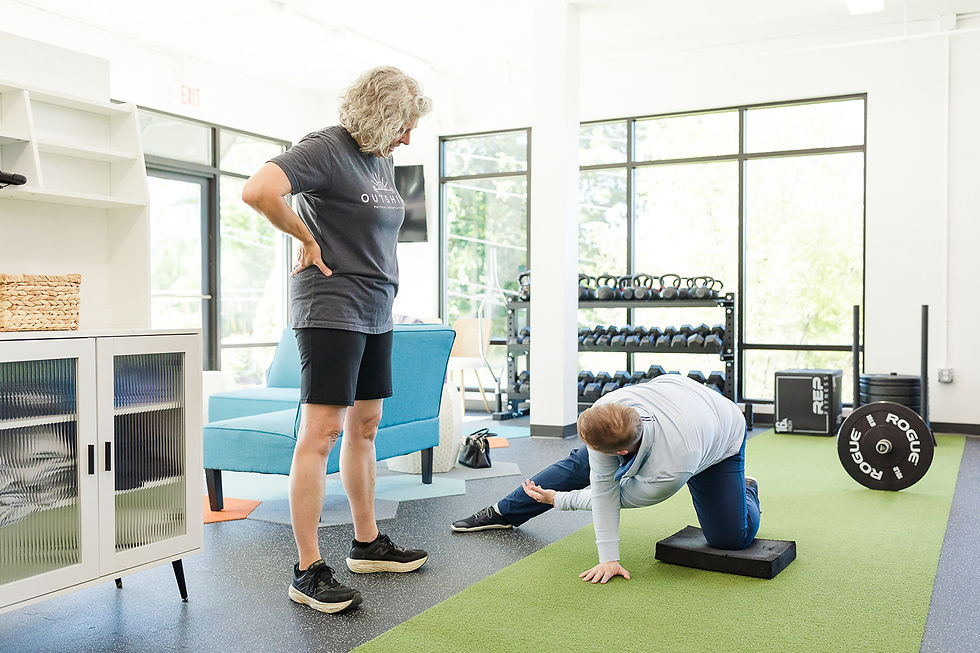Stand more and live longer! Tips to limit your sitting and improve your standing workstation
- Dr. Sieara Hinshaw

- May 18, 2023
- 3 min read
What is the problem with too much sitting?
Sitting can have negative impacts on your health. Too much sitting is linked to obesity, diabetes, cardiovascular disease, some types of cancer, circulation issues, and premature death.
A study by the American Cancer Society found that women and men who sit more than 6 hours a day are, respectively, 37% and 18% more likely to die before people who sit less than 3 hours a day.
From a musculoskeletal perspective, there are some changes that happen to the body from sitting too much as well. Muscles and joints adapt to positions that you spend a lot of time in. This could mean shortened/tight hip flexors, quadriceps, chest, and neck muscles as well as stiffness at the spine and hips. These issues can lead to pain and limitations in movement and performance over time.
How much sitting is too much sitting?
Physical therapist and well-known mobility expert, Kelly Starrett, and his wife, Juliet Starrett, have a great book out that I just read. The book is called Built to Move and they recommend “ten essential habits to help you move freely and live fully”. We know that those who sit for more than 6 hours per day have a higher mortality rate than those who sit for less than 3 hours per day.
Based on this research, the Starrett's recommend limiting your sitting to 6 hours a day or less. I believe this is a good recommendation and one that should be achievable for most people.
Unfortunately, the CDC found that 1 in 4 Americans sit for more than 8 hours per day. Only 3% said they sat for less than 4 hours per day and were active.
We have a lot of work to do as a society in changing how often we sit.
What positions are better than sitting?
Standing is obviously a better choice for a few reasons. Standing allows you to burn more calories than sitting. While it is not a significant amount of calorie difference per day, it adds up substantially over weeks/months/years. Standing instead of sitting can limit the above health risks such as obesity, cardiovascular disease, and more. It can also help with improving circulation and keeping your body in a more efficient and beneficial alignment.
While it’s best to avoid sitting in a chair for more than 6 hours a day, it is actually great to sit on the floor for at least 30 minutes a day. Try to sit in as many different creative positions as possible. This could mean 1-5 minutes rotating between any of these positions: criss cross, hip 90 90, long sit, tall kneeling, half kneeling, full kneeling, etc.
Stand more by setting up a standing workstation:
Feel free to click here for a quick video explanation on how to set up a standing workstation.
You can buy a standing desk or a high low desk. But you don’t have to! You can get a converter kit to raise your current set-up or even build something out of stuff you have around your house.
What is the correct height for a standing desk?
Set your desk height at your elbow height or 1” above your elbow height.
Tips for comfort when standing:
Ideally you should build up to standing for about 45 minutes of every hour with 1-2 short sitting breaks. If you need to sit for longer, you may need to take breaks throughout your workday for short walks or specific movements/stretches for you.
Use an anti-fatigue mat or at least a rug to assist with foot fatigue that might limit your ability to stand.
Use a step stool, a fidget bar, or a fidget strap to place one foot on while you are standing. This will help you offload weight from your lower back and adjust to find better positions of comfort. You can even use these movable foot props while sitting to encourage more movement.
Use a high bar stool to partially sit on with one foot remaining on the floor.
You can also lean against a wall for part of your standing workday if the workspace can be moved close enough to you.
I hope you find some of this information helpful and can make intentional changes in your daily life to sit less in order to stand and move more!
Dr. Sieara Hinshaw
Physical Therapist and Strength Coach






Comments